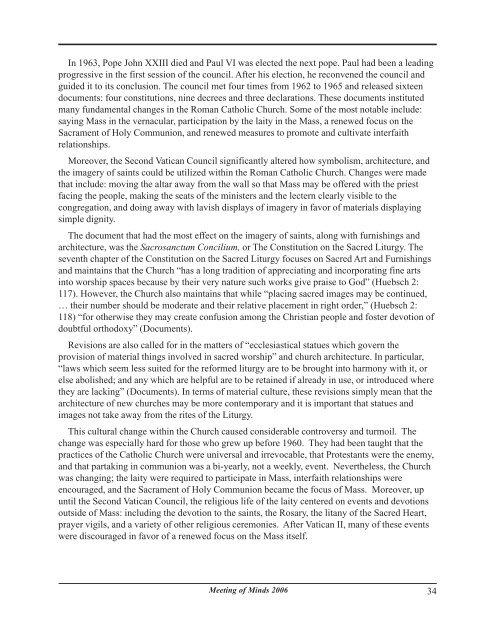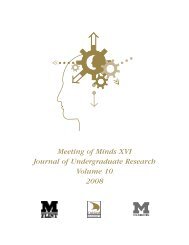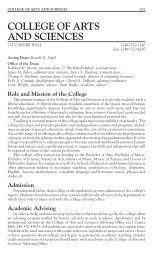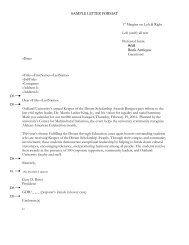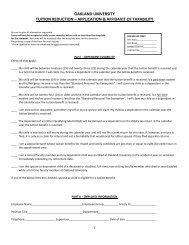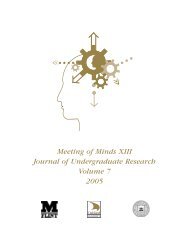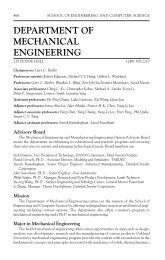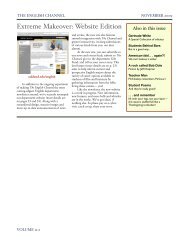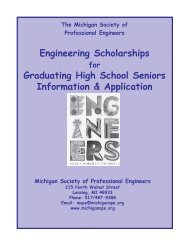MOM 2006 journal for pdf.pmd - University of Michigan-Flint
MOM 2006 journal for pdf.pmd - University of Michigan-Flint
MOM 2006 journal for pdf.pmd - University of Michigan-Flint
You also want an ePaper? Increase the reach of your titles
YUMPU automatically turns print PDFs into web optimized ePapers that Google loves.
In 1963, Pope John XXIII died and Paul VI was elected the next pope. Paul had been a leading<br />
progressive in the first session <strong>of</strong> the council. After his election, he reconvened the council and<br />
guided it to its conclusion. The council met four times from 1962 to 1965 and released sixteen<br />
documents: four constitutions, nine decrees and three declarations. These documents instituted<br />
many fundamental changes in the Roman Catholic Church. Some <strong>of</strong> the most notable include:<br />
saying Mass in the vernacular, participation by the laity in the Mass, a renewed focus on the<br />
Sacrament <strong>of</strong> Holy Communion, and renewed measures to promote and cultivate interfaith<br />
relationships.<br />
Moreover, the Second Vatican Council significantly altered how symbolism, architecture, and<br />
the imagery <strong>of</strong> saints could be utilized within the Roman Catholic Church. Changes were made<br />
that include: moving the altar away from the wall so that Mass may be <strong>of</strong>fered with the priest<br />
facing the people, making the seats <strong>of</strong> the ministers and the lectern clearly visible to the<br />
congregation, and doing away with lavish displays <strong>of</strong> imagery in favor <strong>of</strong> materials displaying<br />
simple dignity.<br />
The document that had the most effect on the imagery <strong>of</strong> saints, along with furnishings and<br />
architecture, was the Sacrosanctum Concilium, or The Constitution on the Sacred Liturgy. The<br />
seventh chapter <strong>of</strong> the Constitution on the Sacred Liturgy focuses on Sacred Art and Furnishings<br />
and maintains that the Church “has a long tradition <strong>of</strong> appreciating and incorporating fine arts<br />
into worship spaces because by their very nature such works give praise to God” (Huebsch 2:<br />
117). However, the Church also maintains that while “placing sacred images may be continued,<br />
… their number should be moderate and their relative placement in right order,” (Huebsch 2:<br />
118) “<strong>for</strong> otherwise they may create confusion among the Christian people and foster devotion <strong>of</strong><br />
doubtful orthodoxy” (Documents).<br />
Revisions are also called <strong>for</strong> in the matters <strong>of</strong> “ecclesiastical statues which govern the<br />
provision <strong>of</strong> material things involved in sacred worship” and church architecture. In particular,<br />
“laws which seem less suited <strong>for</strong> the re<strong>for</strong>med liturgy are to be brought into harmony with it, or<br />
else abolished; and any which are helpful are to be retained if already in use, or introduced where<br />
they are lacking” (Documents). In terms <strong>of</strong> material culture, these revisions simply mean that the<br />
architecture <strong>of</strong> new churches may be more contemporary and it is important that statues and<br />
images not take away from the rites <strong>of</strong> the Liturgy.<br />
This cultural change within the Church caused considerable controversy and turmoil. The<br />
change was especially hard <strong>for</strong> those who grew up be<strong>for</strong>e 1960. They had been taught that the<br />
practices <strong>of</strong> the Catholic Church were universal and irrevocable, that Protestants were the enemy,<br />
and that partaking in communion was a bi-yearly, not a weekly, event. Nevertheless, the Church<br />
was changing; the laity were required to participate in Mass, interfaith relationships were<br />
encouraged, and the Sacrament <strong>of</strong> Holy Communion became the focus <strong>of</strong> Mass. Moreover, up<br />
until the Second Vatican Council, the religious life <strong>of</strong> the laity centered on events and devotions<br />
outside <strong>of</strong> Mass: including the devotion to the saints, the Rosary, the litany <strong>of</strong> the Sacred Heart,<br />
prayer vigils, and a variety <strong>of</strong> other religious ceremonies. After Vatican II, many <strong>of</strong> these events<br />
were discouraged in favor <strong>of</strong> a renewed focus on the Mass itself.<br />
Meeting <strong>of</strong> Minds <strong>2006</strong> 34


